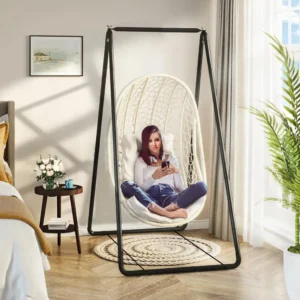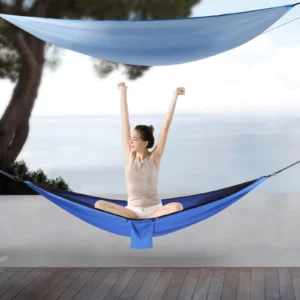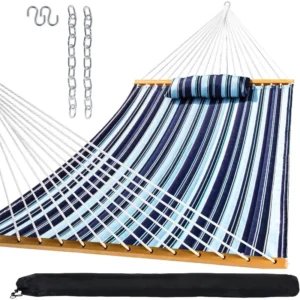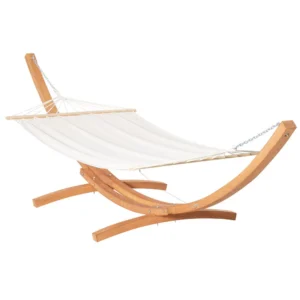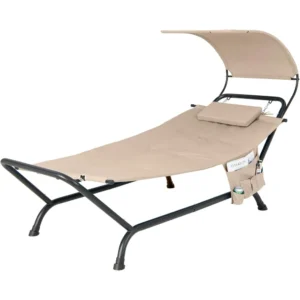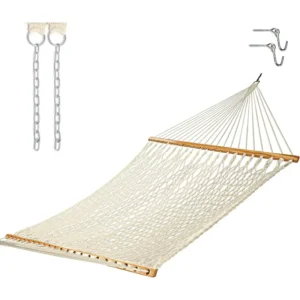Understanding Hammock Fundamentals: Indoor vs. Outdoor Designs
Hammocks have journeyed far from their origins as practical sleeping solutions used by sailors and indigenous peoples of tropical regions. Originally designed to provide safe, off-ground sleeping aboard ships and in forested environments, hammocks have evolved into versatile relaxation tools embraced worldwide for leisure, meditation, and alternative sleeping arrangements.
Indoor hammocks are primarily designed with comfort and aesthetics in mind. These hammocks typically feature softer materials, decorative elements, and construction that complements interior spaces. They transform living rooms, bedrooms, and even office spaces into cozy relaxation zones, often becoming statement pieces in home décor.
Outdoor hammocks, by contrast, prioritize durability, weather resistance, and portability. Built to withstand environmental elements like UV rays, rain, and temperature fluctuations, these hammocks use specialized materials and construction techniques that sacrifice some comfort features for longevity in challenging conditions.
While the distinction between these two categories seems straightforward, many modern hammocks fall somewhere in the middle. With the right accessories and proper care, some hammocks can transition between indoor and outdoor environments, offering flexibility for varying needs and seasons.
As hammocks continue gaining popularity—with sales increasing over 30% in the past five years—understanding the fundamental differences between indoor and outdoor designs becomes essential for making informed hammock placement considerations that match your lifestyle needs.
Key Differences: Indoor vs. Outdoor Hammocks at a Glance
Before diving into the specific advantages and limitations of each hammock type, let’s examine their key differences side by side. These distinctions stem from their intended environments and directly impact your experience, maintenance requirements, and the overall lifespan of your hammock.
| Feature | Indoor Hammocks | Outdoor Hammocks |
|---|---|---|
| Primary Materials | Cotton, polyester blends, macramé | Nylon, polyester, weather-treated cotton, DuraCord |
| Typical Installation | Ceiling mounts, wall anchors, dedicated stands | Tree straps, portable stands, permanent posts |
| Weather Resistance | Minimal to none | Moderate to high (UV-resistant, quick-drying) |
| Durability Focus | Comfort, aesthetics | Structural integrity, material strength |
| Maintenance Needs | Regular dusting, occasional washing | Frequent cleaning, drying after rain, seasonal storage |
| Comfort Features | Soft fabrics, decorative pillows, aesthetic details | Practical features, integrated bug nets, rain flies |
| Portability | Generally limited (except with stands) | Often designed for easy transport |
| Weight Capacity | 250-350 lbs typically | 300-500+ lbs for outdoor/camping models |
| Price Range | $50-$300+ (quality/design dependent) | $30-$400+ (feature/material dependent) |
| Lifespan Expectancy | 5-10+ years with proper care | 2-7 years depending on exposure |
The differences extend beyond these basic specifications. Indoor hammocks often feature delicate craftsmanship with decorative fringe, tassels, or intricate weaving patterns that wouldn’t withstand outdoor conditions. Meanwhile, outdoor hammocks prioritize reinforced stitching, specialized coatings, and quick-connect hardware systems.
Understanding material differences is particularly important when choosing between cotton, polyester, and rope hammocks as each offers distinct benefits and drawbacks depending on your intended use.
Indoor Hammocks: Advantages for Home Relaxation
Indoor hammocks transform ordinary living spaces into personal retreats with several compelling benefits:
Year-round enjoyment regardless of weather – Rain, snow, or scorching heat outside? Your indoor hammock remains perfectly usable and comfortable regardless of seasonal changes.
Design integration with home décor – Indoor hammocks come in various styles, from bohemian macramé to minimalist cotton canvas, allowing them to enhance your interior design rather than clash with it.
Extended lifespan through protected environment – Without exposure to UV rays, moisture, or temperature fluctuations, indoor hammocks maintain their color, strength, and appearance significantly longer than outdoor alternatives.
Space-efficient relaxation solution – In small apartments or homes where space is premium, hammocks provide comfortable lounging without the footprint of traditional furniture, especially when using wall mounts or over-furniture placements.
Controlled comfort environment – Free from insects, wind, debris, and unexpected weather changes, indoor hammocks provide consistent comfort without interruptions.
Sleep benefits supported by research – Studies suggest that the gentle rocking motion of hammocks promotes faster sleep onset and deeper sleep cycles by synchronizing brain waves, making indoor hammocks particularly valuable for those with sleep difficulties.
Many users report that their indoor hammocks become favorite reading nooks, meditation spaces, or even primary sleeping arrangements. The growing trend of incorporating hammocks into interior design speaks to their versatility beyond mere novelty furniture.
While considering whether it’s safe to hang a hammock indoors, proper installation becomes crucial. With correct mounting and weight distribution, indoor hammocks can safely support daily use while adding both functionality and visual interest to your home. Finding the best places to hang a hammock indoors requires considering both structural support and how the space flows around this suspended relaxation spot.
Indoor Hammocks: Limitations to Consider
Despite their many advantages, indoor hammocks present several challenges worth considering before installation:
Space requirements can be substantial – While hammocks save floor space compared to sofas or chairs, they require significant cubic footage when hung. The typical indoor hammock needs 10-15 feet of linear space when fully extended.
Installation complexity and structural requirements – Proper indoor mounting demands locating ceiling joists or wall studs capable of supporting your weight. In many modern homes and apartments, finding adequate structural support can be challenging and may require professional assessment.
Potential property damage concerns – Renters particularly face limitations as landlords may prohibit the drilling or mounting required for secure hammock installation. Even with permission, improper mounting can cause significant structural damage.
Limited natural environment connection – Indoor hammocks miss the connection to fresh air, natural sounds, and the psychological benefits associated with outdoor relaxation.
Room flexibility reduction – Once permanently mounted, a hammock defines that space’s function, potentially limiting room versatility compared to movable furniture.
Material considerations for regular indoor use – Some indoor hammock materials may develop odors or collect dust more readily than outdoor materials designed for easy cleaning.
Understanding these limitations doesn’t negate the appeal of indoor hammocks but helps set realistic expectations. Many of these challenges can be addressed through careful hammock installation requirements and safety guidance that accounts for your specific living situation and structural environment.
Freestanding hammock stands offer solutions for renters or those concerned about permanent installation, though these require floor space and may not provide the same stability as properly mounted systems.
Outdoor Hammocks: Benefits of Open-Air Relaxation
Outdoor hammocks provide unique advantages that indoor environments simply cannot replicate:
Immersion in nature’s therapeutic elements – From the gentle filtering of sunlight through trees to the natural sounds of birds and rustling leaves, outdoor hammocks connect you directly to nature’s stress-reducing elements that indoor environments cannot reproduce.
Versatility across multiple settings – A quality outdoor hammock transitions easily from backyard to campsite, beach to park, making it a multi-functional investment for various outdoor activities.
Weather-resistant durability – Modern outdoor hammocks use advanced materials like ripstop nylon, treated polyester, and specialized coatings that withstand UV exposure, moisture, and temperature variations far better than their indoor counterparts.
Enhanced airflow and cooling – The open-air design combined with breathable materials provides natural cooling during warm weather, creating a comfortable microclimate even on hot days.
Social centerpiece potential – Outdoor hammocks naturally attract gatherings, creating conversation spaces and social hubs in backyard environments.
Expandable functionality with accessories – The addition of bug nets and protective canopies allows outdoor hammocks to function in various weather conditions and protect against insects without sacrificing the outdoor experience.
Health benefits of outdoor exposure – Research consistently shows that time spent outdoors increases vitamin D production, improves mood, and enhances overall well-being—all benefits complemented by hammock relaxation.
Outdoor hammocks particularly excel during camping trips, where they provide comfortable, elevated sleeping arrangements that protect from ground moisture, insects, and uneven terrain. Their lightweight portability makes them increasingly popular alternatives to traditional tents for minimalist campers and backpackers.
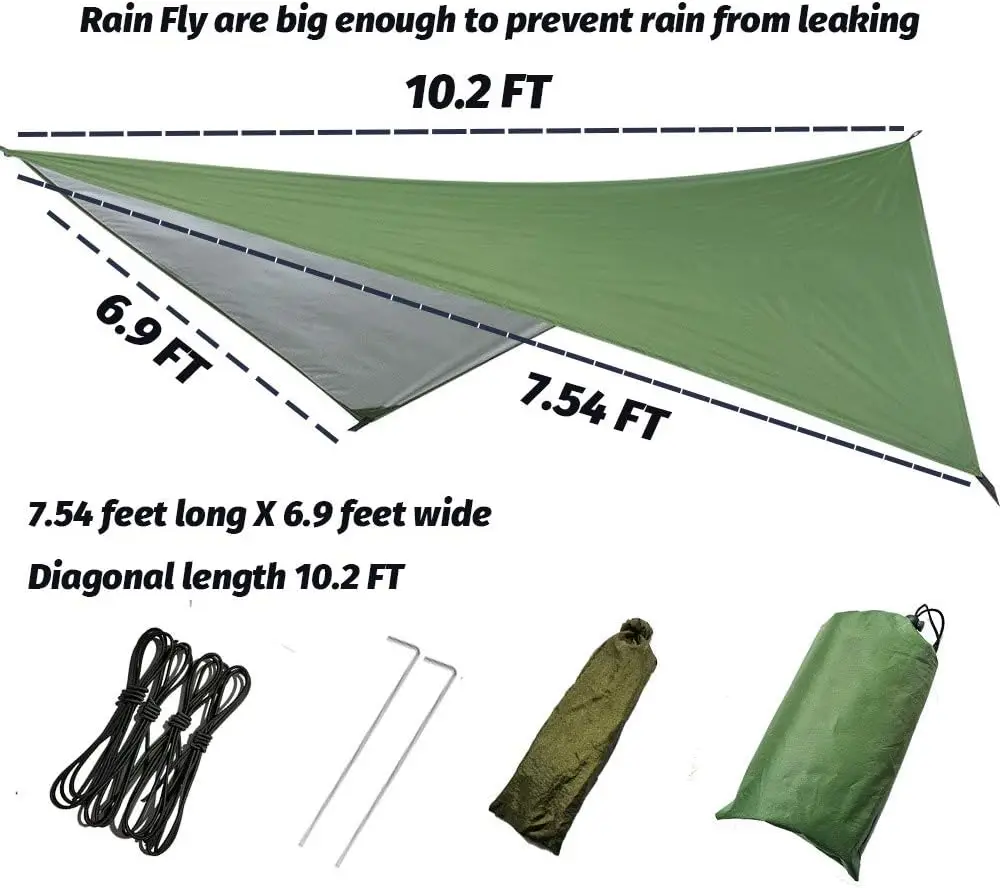
Outdoor Hammocks: Challenges to Overcome
Despite their appeal, outdoor hammocks present several challenges that require consideration:
Weather vulnerability despite resistant materials – Even the most weather-resistant hammocks eventually show signs of UV degradation, color fading, and strength reduction when continuously exposed to the elements.
Regular maintenance requirements – Outdoor hammocks need consistent cleaning to remove tree sap, bird droppings, pollen, and accumulated dirt that can degrade materials over time.
Installation limitations based on environment – Many outdoor settings lack suitable anchor points, requiring either portable stands or limiting use to areas with appropriately spaced trees or posts.
Seasonal usability restrictions – In many climates, outdoor hammocks become impractical during winter months or rainy seasons without significant additional equipment.
Unpredictable comfort factors – Temperature fluctuations, insect activity, and changing weather conditions can interrupt otherwise pleasant hammock experiences.
Storage needs during off-seasons – Properly storing outdoor hammocks during harsh weather periods requires both space and proper techniques to prevent mildew, rodent damage, or material degradation.
Potential environmental impact – Improper hammock hanging techniques can damage tree bark and impact local ecosystems, requiring responsible use and appropriate tree-friendly straps.
Understanding whether it’s okay to leave a hammock outside becomes essential for maximizing its lifespan. Most outdoor hammocks benefit from being taken down between uses or at least during extended periods of harsh weather. Even “all-weather” options require periodic maintenance and proper seasonal storage to maintain their functionality over multiple years.
Material Matters: Choosing the Right Fabric for Your Needs
The material of your hammock fundamentally determines its comfort, durability, and appropriate usage environment:
Cotton
* Benefits: Unmatched softness against skin, excellent breathability, natural temperature regulation, attractive natural appearance
* Limitations: Highly susceptible to mold/mildew when wet, breaks down under UV exposure, requires frequent cleaning, longer drying time
* Best for: Indoor use, covered porches, occasional fair-weather outdoor use with proper storage
Polyester
* Benefits: Excellent weather resistance, good color retention, moderate durability, reasonable comfort, affordable price point
* Limitations: Less breathable than cotton, can feel synthetic against skin, moderately susceptible to UV damage over time
* Best for: Casual outdoor use, semi-protected environments, situations requiring balance between comfort and durability
Nylon
* Benefits: Superior strength-to-weight ratio, quick-drying properties, high tear resistance, excellent packability, lightweight
* Limitations: Less comfortable directly against skin, can feel slippery, generates more heat during warm weather
* Best for: Camping, backpacking, travel hammocks, situations where weight and packability matter
Specialized Materials
* DuraCord: Combines cotton-like softness with polyester-like weather resistance, superior for long-term outdoor installations
* Olefin: Exceptionally fade-resistant, quick-drying, resistant to mildew and chemicals, ideal for pool areas
* Textilene: Mesh-like material offering excellent airflow, UV resistance, and minimal water retention
The best materials for outdoor hammocks depend largely on your specific environment and usage patterns. For areas with frequent rain, quick-drying synthetic materials prove essential. For primarily sunny locations, UV-resistant fabrics with fade protection become more important.
Material weight, measured in denier for synthetics, also impacts performance. Lightweight backpacking hammocks might use 40-70 denier nylon, while heavy-duty outdoor hammocks might employ 210+ denier fabrics for enhanced durability at the cost of additional weight.
Installation Essentials: From Trees to Stands
Proper installation not only ensures safety but also maximizes comfort and hammock lifespan:
Indoor Mounting Options:
* Ceiling Joists: The most secure indoor mounting requires finding and anchoring to ceiling joists using appropriate hardware rated for at least 600 pounds
* Wall Mounts: Requires identifying wall studs and using brackets specifically designed for hammock tension forces
* Door Frame Anchors: Temporary solutions that utilize tension against door frames without permanent installation
* Stands: Freestanding structures requiring no mounting but occupying floor space and providing variable stability
Outdoor Installation Methods:
* Tree Straps: Wide, non-damaging straps (minimum 1.5” wide) that distribute weight and protect tree bark
* Posts/Beams: Permanently installed wooden or metal posts set in concrete for dedicated hammock spaces
* Portable Stands: Collapsible or disassemblable structures allowing hammock use without natural anchor points
* Rock Climbing Anchors: Specialized equipment for unique outdoor environments where traditional methods aren’t possible
Critical Safety Considerations:
* Always install with a 30% safety margin above the hammock’s listed weight capacity
* Maintain proper hanging height (usually 18-24 inches from the ground when weighted)
* Ensure anchor points are at least 12-15 feet apart for standard hammocks
* Use hardware specifically rated for dynamic/hanging loads, not static loads
* Regularly inspect all connection points, hardware, and support structures
For outdoor installations, the distance between trees or posts significantly affects sag angle—the optimal angle being 30 degrees from horizontal when weighted, which balances comfort and strain on anchor points. Most wooden arc stand hammock sets are designed with this optimal geometry already incorporated into their design.
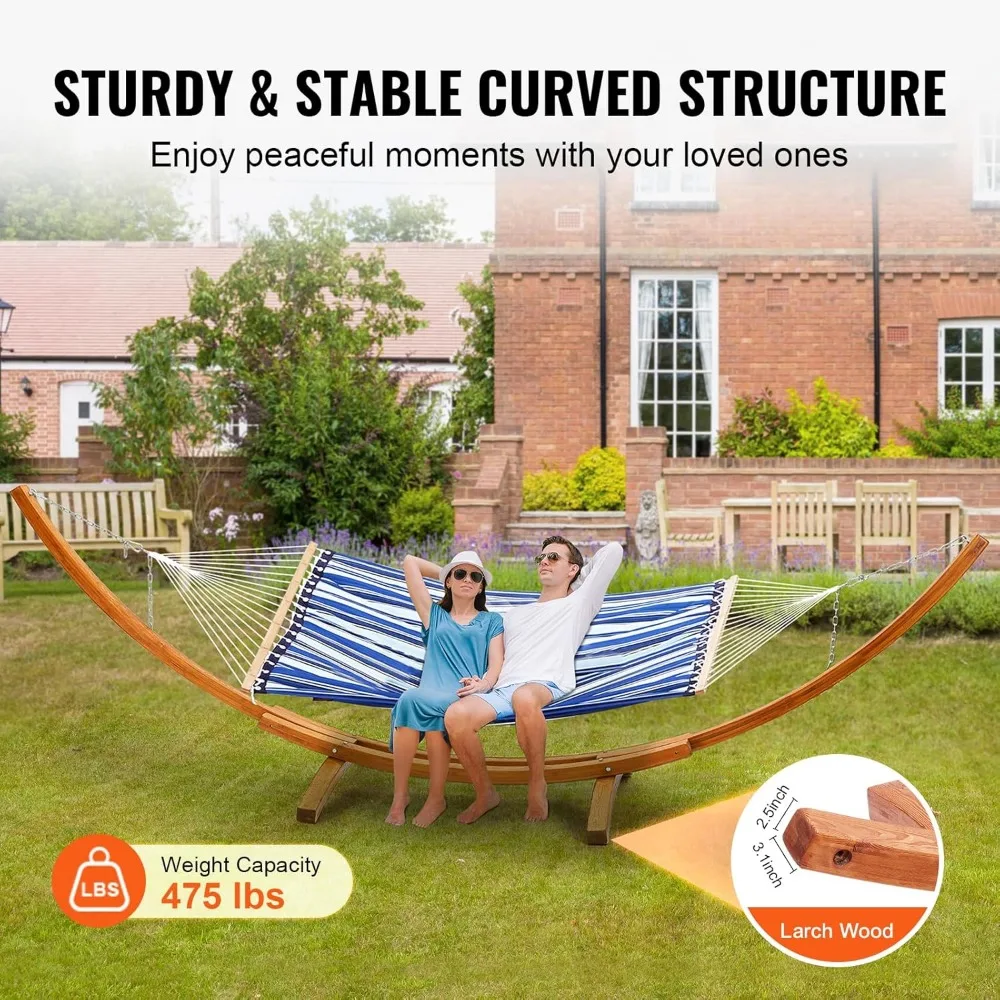
Finding Your Perfect Match: Scenarios and Recommendations
Different lifestyle needs demand different hammock solutions. Consider these common scenarios:
Small Apartment Dwellers
* Primary Need: Space efficiency without permanent installation
* Ideal Solution: Lightweight stand-based indoor hammock or door-frame mounting system
* Key Features: Compact storage capability, easy assembly/disassembly, aesthetically pleasing design
* Material Priority: Cotton or cotton blends for comfort in primary living space
Avid Campers and Hikers
* Primary Need: Lightweight portability with weather protection
* Ideal Solution: Ultralight nylon hammock with integrated or separate bug net and rain fly
* Key Features: Stuff sack, minimal weight (under 2 pounds), quick-attach suspension system
* Material Priority: Ripstop nylon with appropriate denier for expected conditions
Backyard Retreat Creators
* Primary Need: Durable, visually appealing outdoor relaxation
* Ideal Solution: Weather-resistant hammock with dedicated stand or permanent post installation
* Key Features: UV protection, quick-drying capability, aesthetic harmony with landscape
* Material Priority: DuraCord, solution-dyed acrylic, or high-quality polyester
Regular Hammock Sleepers
* Primary Need: Ergonomic support and comfort for extended periods
* Ideal Solution: Double-layer hammock with adequate width for diagonal laying position
* Key Features: No spreader bars (prevents flat lay), structural ridgeline for consistent sag
* Material Priority: Breathable, soft fabrics that manage moisture and temperature
Finding your ideal placement may require experimenting with different locations. The principles of perfect hammock placement for home and garden suggest considering both practical elements like anchor point availability and experiential factors like view, shade patterns, and proximity to indoor/outdoor transitions.
Maximizing Comfort: Essential Accessories and Add-ons
The right accessories transform basic hammocks into customized relaxation systems:
Comfort Enhancers:
* Hammock pillows (specially shaped to prevent neck strain)
* Underquilts that provide bottom insulation without compressing like regular blankets
* Hammock-specific pads that resist slipping and maintain position
* Ridgelines that ensure consistent sag angle regardless of hanging distance
Weather Protection:
* Rain flies positioned to channel water away from the hammock body
* Winter tarps with extended coverage for cold-weather insulation
* Underquilts that provide critical bottom insulation (where compressed sleeping bags fail)
* Hammock socks that envelop the entire system for wind protection
Insect Protection:
* Integrated or separate bug nets with fine mesh to block even no-see-ums
* Permethrin treatments for fabric (safe when dry, highly effective)
* Entry/exit zippers designed for minimal disruption when getting in/out
Convenience Features:
* Structural ridgelines with integrated gear organizers
* Side-sling storage pockets for phones, books, or water bottles
* Drink holders that stabilize beverages within reach
* Quick-connect hardware systems for tool-free setup
Complete camping hammock systems integrate many of these features into cohesive packages, eliminating compatibility concerns and providing comprehensive protection from various environmental challenges.
A-Frame Stand Hammock Sets, Swinging Hammock Chair Sets
$154.62 Select options This product has multiple variants. The options may be chosen on the product pageCamping Hammock Sets with Bug Net, Ultralight Camping Hammock Sets
$139.72 Select options This product has multiple variants. The options may be chosen on the product pageClassic Wooden Stand Hammock Sets, Heavy Duty Hammock Sets
$1,061.68 Select options This product has multiple variants. The options may be chosen on the product pageHammock Sets with Canopy, Heavy Duty Hammock Sets
$286.31 Select options This product has multiple variants. The options may be chosen on the product pageDouble / Two Person Hammock Sets, Rope Hammock Sets
Double Traditional Cotton Rope Hammock with Extension Chains – 450 lbs Capacity for Backyard & Patio$292.98 Select options This product has multiple variants. The options may be chosen on the product page
Care and Maintenance: Extending Your Hammock’s Lifespan
Proper maintenance dramatically extends hammock lifespan, regardless of indoor or outdoor designation:
Cleaning Protocols:
* Cotton hammocks: Hand wash with mild soap, rinse thoroughly, air dry completely before storage
* Synthetic hammocks: Machine wash gentle cycle with technical fabric cleaner, hang dry
* Rope hammocks: Scrub with soft brush and mild soap solution, rinse completely, dry in sun
* Hardware: Wipe clean and check for rust or corrosion, applying lubricant to moving parts
Storage Best Practices:
* Always store completely dry to prevent mildew growth
* Indoor hammocks: Loosely fold rather than tightly bundle to prevent permanent creases
* Outdoor hammocks: Store in breathable bags away from direct sunlight
* Seasonal storage: Clean thoroughly before storing for extended periods
Regular Inspection Points:
* Examine all stitching for signs of unraveling or UV damage
* Check connection points for fraying or wear patterns
* Inspect hardware for bending, cracking, or corrosion
* Look for fabric thinning, especially at pressure points and edges
UV Protection Strategies:
* Apply fabric-specific UV protectants to outdoor hammocks
* Remove from direct sunlight when not in use
* Consider shade patterns when positioning permanent installations
* Recognize that even UV-resistant fabrics benefit from limited exposure
Following these guidelines makes the difference between a hammock that lasts a single season and one that provides many years of enjoyment. Understanding proper indoor and outdoor hammock safety not only protects the hammock but ensures your relaxation remains worry-free.
Can a Hammock Replace My Bed? Health and Comfort Considerations
The question of hammocks as primary sleeping surfaces has gained substantial attention in recent years, supported by both traditional practices and modern research:
Potential Benefits:
* The gentle rocking motion promotes deeper sleep and potentially faster sleep onset
* Proper diagonal positioning in a hammock provides excellent spinal alignment for many sleepers
* Elevation eliminates dust mite exposure common in mattresses
* Pressure point reduction compared to firm mattresses, particularly beneficial for some back pain sufferers
Important Considerations:
* Side sleepers may find adaptation more challenging than back sleepers
* Temperature regulation requires different strategies than conventional beds
* Partner sleeping requires specialized two-person designs or separate hammocks
* Some users need 2-4 weeks to fully adjust to the different sleep position
Transition Tips:
* Begin with naps before attempting full nights
* Ensure proper diagonal positioning (lay at approximately 30° angle from centerline)
* Use a small pillow only under your head, not shoulders
* Consider starting with an indoor setup before committing to outdoor sleeping
While many cultures have traditionally used hammocks as primary sleeping arrangements, individual comfort varies significantly. Quality hammocks with stands designed specifically for sleeping provide better experiences than recreational models, with appropriate width (minimum 5 feet) and proper suspension systems being crucial factors.
Are Hammocks Safe? Addressing Common Concerns
Safety concerns often prevent potential hammock users from enjoying their benefits. Understanding and addressing these concerns provides peace of mind:
Weight Capacity Considerations:
* Always observe manufacturer weight ratings with a 20-30% safety margin
* Dynamic weight (getting in/out) places more stress than static weight (lying still)
* Two-person hammocks should specify “two-person capacity” explicitly, not just a weight rating
* Hardware failure is the most common safety issue, not fabric tearing
Installation Safety:
* Wall anchors must connect to studs, not just drywall
* Ceiling mounts require joist connection, not just ceiling material
* Outdoor trees should be healthy, alive, and minimum 8 inches in diameter
* Stand stability depends on correct assembly and level placement
Fall Prevention:
* Proper height is typically 18-24 inches from ground when weighted
* First-time users should practice entry/exit techniques at low heights
* Keep hammock area clear of hard or sharp objects
* Consider side-entry techniques rather than end-entry for greater stability
Children and Pet Safety:
* Never leave young children unsupervised in hammocks
* Teach proper entry/exit techniques before independent use
* Keep hammock secured when not in use to prevent accidental falls
* Consider hammock stands rather than ceiling mounts for homes with active children
Most safety concerns stem from improper installation or exceeding weight capacities rather than inherent hammock design issues. Portable hammocks with stands often provide the safest introduction to hammock use, as they eliminate most installation risks while maintaining stability.
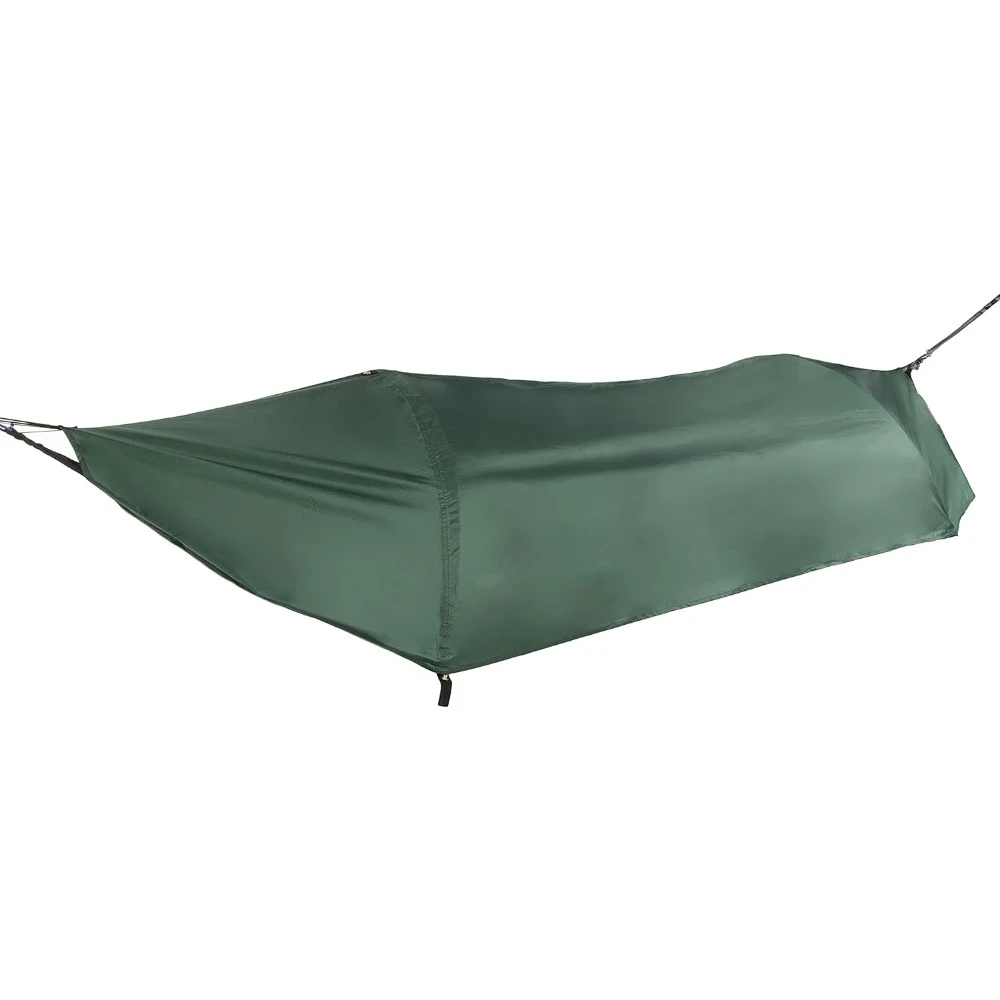
Conclusion: Making Your Final Decision
As we’ve explored throughout this guide, the choice between indoor and outdoor hammocks ultimately depends on your specific needs, environment, and intended use. Here’s a simplified decision framework to help finalize your choice:
Choose an indoor hammock if:
* You prioritize year-round comfort regardless of weather
* Aesthetic integration with home décor is important
* You have limited exposure to suitable outdoor hanging locations
* You’re seeking an alternative or supplementary sleeping arrangement
* Protection from insects and environmental elements is essential
Choose an outdoor hammock if:
* You frequently camp, hike, or spend time in natural settings
* You have a suitable yard, patio, or outdoor space with anchor points
* You value connection with nature and fresh air during relaxation
* Portability and versatility across multiple environments matter to you
* You’re willing to perform regular maintenance for weather exposure
Remember that quality indicators—such as reinforced stitching, appropriate weight ratings, and reputable manufacturing—matter regardless of your indoor/outdoor choice. A well-made hammock often provides better value through extended lifespan than budget alternatives requiring frequent replacement.
As you create your perfect hammock haven, focus on the experience you’re seeking rather than strictly adhering to conventional categories. The best hammock is ultimately the one that provides the relaxation experience you desire in the environments you frequent most.
Are Dual-Purpose Hammocks Worth Considering?
For those struggling to choose between indoor and outdoor options, dual-purpose hammocks offer an appealing middle ground:
Advantages of Versatile Designs:
* Cost-effectiveness through single purchase serving multiple environments
* Simplified storage and maintenance with one system instead of separate setups
* Opportunity to experiment with various locations before committing to specialized equipment
* Easier transitions between seasonal uses without additional purchases
Compromise Factors to Consider:
* Materials balancing comfort and weather resistance may not excel at either
* Design elements accommodating both environments might include unnecessary features for single-environment use
* Typically heavier than dedicated indoor or dedicated ultralight outdoor options
* May require additional accessories to optimize for specific environments
Features That Enhance Versatility:
* Modular design allowing attachment/removal of weather protection elements
* Materials with balanced properties (e.g., soft but quick-drying)
* Convertible suspension systems working with both indoor hardware and outdoor straps
* Neutral aesthetics appropriate for both interior spaces and natural settings
The best candidates for dual-purpose use are mid-weight polyester or DuraCord hammocks that balance comfort, durability, and weather resistance. Ultralight camping hammock sets can also serve dual purposes when paired with comfortable indoor accessories, offering exceptional versatility while maintaining portability.
When properly maintained through regular cleaning and appropriate storage between environment changes, quality dual-purpose hammocks can provide the best of both worlds without significant compromise in either setting.


